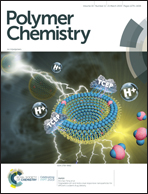End-group ionisation enables the use of poly(N-(2-methacryloyloxy)ethyl pyrrolidone) as an electrosteric stabiliser block for polymerisation-induced self-assembly in aqueous media†
Abstract
A series of near-monodisperse poly(N-2-(methacryloyloxy)ethyl pyrrolidone) (PNMEP) homopolymers was prepared via reversible addition–fragmentation chain transfer (RAFT) solution polymerisation of NMEP in ethanol at 70 °C using a carboxylic acid-functional RAFT agent. The mean degree of polymerisation (DP) was varied from 19 to 89 and acid titration indicated end-group pKa values of 5.07–5.44. Turbidimetry studies indicated that homopolymer cloud points were significantly higher at pH 7 (anionic carboxylate) than at pH 3 (neutral carboxylic acid). Moreover, this enhanced hydrophilic character enabled PNMEP to be used as a steric stabiliser for aqueous polymerisation-induced self-assembly (PISA) syntheses. Thus, a PNMEP42 precursor was chain-extended via RAFT aqueous dispersion polymerisation of 2-hydroxypropyl methacrylate (HPMA) at 44 °C. A series of PNMEP42-PHPMAx diblock copolymers were synthesised using this protocol, with target PHPMA DPs of 150 to 400. High conversions were achieved and a linear evolution in Mn with increasing PHPMA DP was observed. Dynamic light scattering (DLS) and transmission electron microscopy (TEM) studies confirmed a spherical morphology in all cases. The nanoparticles flocculated either below pH 4.5 (owing to protonation) or on addition of 60 mM KCl (as a result of charge screening). Thus the anionic end-groups on the PNMEP stabiliser chains make an important contribution to the overall colloidal stability. Similarly, a PNMEP53 macro-CTA was chain-extended via RAFT aqueous emulsion polymerisation of 2-ethoxyethyl methacrylate (EEMA) at 44 °C. Again, a neutral solution pH was critical for the synthesis of colloidally stable nanoparticles. High conversions were achieved as the target PEEMA DP was varied between 100 and 600 and a linear evolution in molecular weight with PEEMA DP was confirmed by chloroform GPC studies. DLS experiments indicated a monotonic increase in nanoparticle diameter with PEEMA DP and TEM studies confirmed a spherical morphology in each case. In summary, PNMEP can be used as a water-soluble steric stabiliser for aqueous PISA syntheses provided that it contains an anionic carboxylate end-group to enhance its hydrophilic character.



 Please wait while we load your content...
Please wait while we load your content...